Imaginary Joint: Proprioceptive Feedback for Virtual Body Extensions via Skin Stretch Abstract Virtual body extensions such as a wing or tail have the potential to offer users new bodily experiences and capabilities in virtual and augmented reality. To use these extensions as naturally as one’s own body—particularly for body parts that are normally hard to see, such as a tail—it is essential to provide proprioceptive […]
Posted: 19/08/2025
Under:
Move with Style! Enhancing Avatar Embodiment in Virtual Reality through Proprioceptive Motion Feedback Abstract In virtual reality (VR), users slip into a variety of roles, represented by a rich diversity of avatars that each exhibit specific visual attributes and motionstyles. While users can see their avatar’s motion in VR, they usually cannot feel it. To enhance avatar embodiment, we propose active proprioceptive feedback that aligns […]
Posted: 12/08/2025
Under:
GestureCoach: Rehearsing for Engaging Talks with LLM-Driven Gesture Recommendations Abstract This paper introduces GestureCoach, a system designed to help speakers deliver more engaging talks by guiding them to gesture effectively during rehearsal. GestureCoach combines an LLM-driven gesture recommendation model with a rehearsal interface that proactively cues speakers to gesture appropriately. Trained on experts’ gesturing patterns from TED talks, the model consists of two modules: an […]
Posted: 12/08/2025
Under:
Texergy: Textile-based Harvesting, Storing, and Releasing of Mechanical Energy for Passive On-Body Actuation Abstract Humans instinctively manipulate and “actuate” their clothing, for instance, to adapt to the environment or to modify aesthetics. However, such manual actuation remains in exible and directly tied to user action. We introduce Texergy, a textile-based technical framework that decouples user input and actuated output to make passive on-body actuation interactive […]
Posted: 12/08/2025
Under:
Biomaterials for Prototyping in HCI Abstract While prototyping is a widespread practice among researchers, creating sustainable, functional devices remains challenging due to the limited range of available tools and materials. We present several approaches to sustainable prototyping of functional devices. Our methods range from using bio-based and bio-degradable materials as sustainable alternatives to biologically growing electronic substrates. These methods enable a new class of interactive […]
Posted: 11/08/2025
Under:
Living Layers: Designing Modular E-Skin with Bacterial Cellulose Abstract Due to its flexibility and sensitivity, E-skin is increasingly used in applications in fields such as Human-Computer Interaction (HCI), biomedical engineering, and robotics. However, current e-skin technologies face challenges related to durability, self-healing, and sustainability. Addressing these issues, sustainable materials offer promising alternatives with unique physical properties. In this context, we explore how the inherent characteristics […]
Posted: 11/08/2025
Under:
ExoKit: A Toolkit for Rapid Prototyping of Interactions for Arm-based Exoskeletons Exoskeletons open up a unique interaction space that seamlessly integrates users’ body movements with robotic actuation. Despite its potential, human-exoskeleton interaction remains an underexplored area in HCI, largely due to the lack of accessible prototyping tools that enable designers to easily develop exoskeleton designs and customized interactive behaviors. We present ExoKit, a do-it-yourself toolkit […]
Posted: 14/02/2025
Under:
3HANDS Dataset: Learning from Humans for Generating Naturalistic Handovers with Supernumerary Robotic Limbs Abstract Supernumerary robotic limbs are robotic structures integrated closely with the user’s body, which augment human physical capabilities and necessitate seamless, naturalistic human-machine interaction. For effective assistance in physical tasks, enabling SRLs to hand over objects to humans is crucial. Yet, designing heuristic-based policies for robots is time-consuming, difficult to generalize across […]
Posted: 12/02/2025
Under:
Embrogami: Shape-Changing Textiles with Machine Embroidery Abstract Machine embroidery is a versatile technique for creating custom and entirely fabric-based patterns on thin and conformable textile surfaces. However, existing machine-embroidered surfaces remain static, limiting the interactions they can support. We introduce Embrogami, an approach for fabricating textile structures with versatile shape-changing behaviors. Inspired by origami, we leverage machine embroidery to form finger-tip-scale mountain-and-valley structures on […]
Posted: 27/08/2024
Under:
Capacitive Touch Sensing on General 3D Surfaces Abstract Mutual-capacitive sensing is the most common technology for detecting multi-touch, especially on flat and simple curvature surfaces. Its extension to a more complex shape is still challenging, as a uniform distribution of sensing electrodes is required for consistent touch sensitivity across the surface. To overcome this problem, we propose a method to adapt the sensor layout […]
Posted: 22/07/2024
Under:
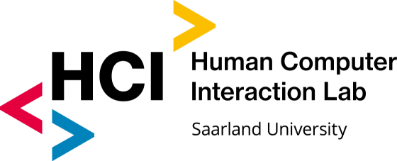
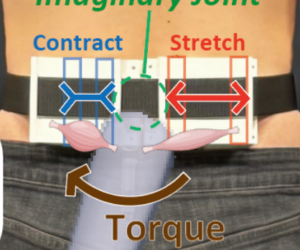
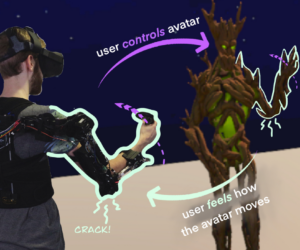
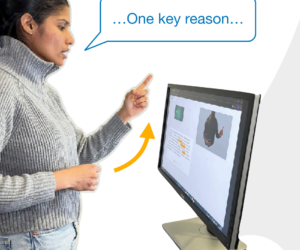

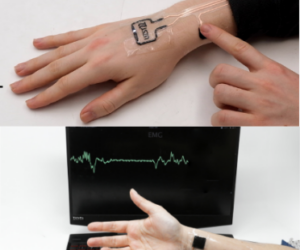
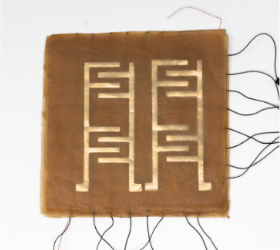
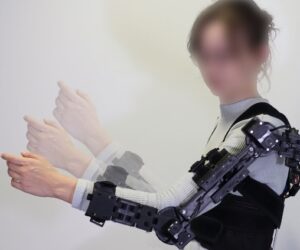

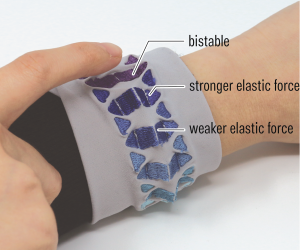
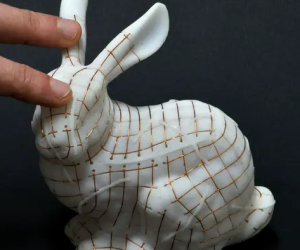

Recent Comments